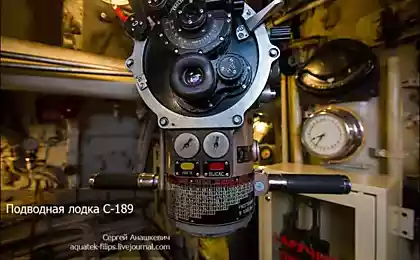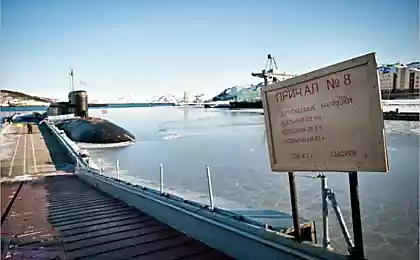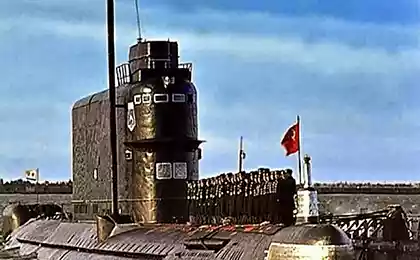882
Submarine S-189
After World War II to the Soviet military industry it sets a global challenge - providing the army with modern military equipment, capable of withstanding the strongest opponents to exceed them. In many Soviet design bureaus work started on the development of new tanks, aircraft, ships ...
One of the hundreds of KB was CDB-18, where he developed an entirely new type of submarine, dubbed Project-613.
In 1950, it had been launched the first vessel of the new project, which has become the most widespread type of attack submarines in the postwar history of the USSR. Total from 1951 to 1958 was built 215 submarines of this project in the USSR, and 21 - in China.
32 Photo © Sergey Anashkevich
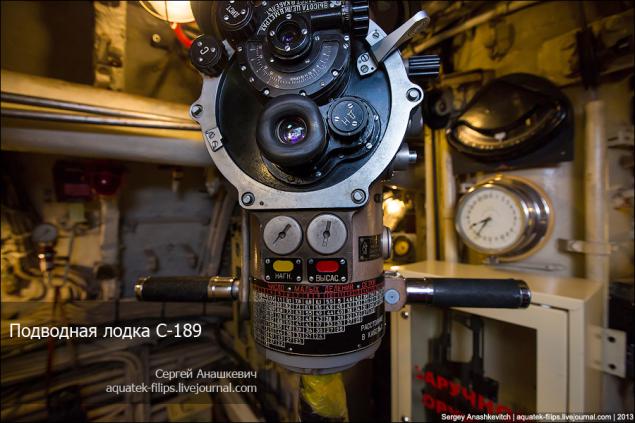
Marine C-189 project 613 has been laid at the Baltic plant March 31, 1954 and launched on 4 September. In addition to military campaigns, she participated in the testing of new models of weapons at the site of Lake Ladoga. Until 1988 it passed a diving school thousands of sailors, sergeants and officers. After serving almost 35 years, he was removed from the Navy in 1990 and later, in 1999, sank in the port of Kronstadt Merchant harbor, sunk at the dock on the ground because of the loss of buoyancy.
In 2005, at the expense of a businessman and a former submariner Andrew Artyushina submarine was raised and placed in the dock on Kanonersky factory where has found a second birth. After the repair and restoration of the interiors on its base was created a private museum, which opened March 18, 2010 at the Lieutenant Schmidt quay in St. Petersburg.

3. In 1942, the designers of CDB-18 began to work on the draft of a new medium submarine, designed to replace the boats of the "Pike." The project was number 608, was appointed chief engineer VN Peregoudov. In 1944, both projects were submitted to the Office of shipbuilding, but did not receive support from the non-fulfillment of the requirements for armament and range.
July 30, 1944 in the Gulf was sunk by a German submarine U-250 Type VIIC. Sunken at a depth of 27 meters in October, lifted the boat and towed to Kronstadt. The People's Commissar of the Navy NG Kuznetsov in January 1945 issued an order according to which stopped work on the project 608 and 613 began to create a project that was to be based on the structure of the German boat, but with a slight increase in tonnage from 770 to 800 tonnes . After the war, Soviet specialists familiar with the unfinished German "elektrolodkami" type XXI, who were captured in the shipyards of Danzig. In the spring of 1946 from the United Kingdom were received four unfinished boat type XXI. The result of sea trials of these ships was a complete change in the terms of reference for the project 613 in August 1946, and the type XXI was used as the basis of a new draft of the main post-war Soviet submarine. Draft project was completed in October 1947, working drawings were prepared by August 1948.
The construction of submarines of Project 613 was conducted from 1950 to 1957. Annual production reached 73 units.

4. Project 613 has a double-hulled design. All-welded robust housing with an external placement of the frames is divided by watertight bulkheads 7 compartments - 2 torpedo residential, 2 battery housing, the central post, diesel, Electromotive

5. Descent, or if I may say so, "main entrance" into a submarine

6. Right from the entrance, we find ourselves in the fourth section, which is the battery. I must say that each of the compartments of any submarine has a lot more purpose, what may appear to be based on its name.
So, in the 4th (the battery) the battery compartment located 112 46SU (below deck in the storage pit), galley, mess room and cabins warrant, electric compressors, high pressure air cylinders, etc.
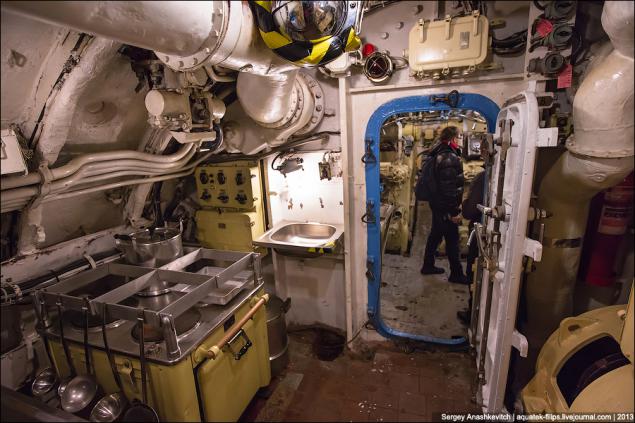
7. In the galley there is even stocks dried roach ...
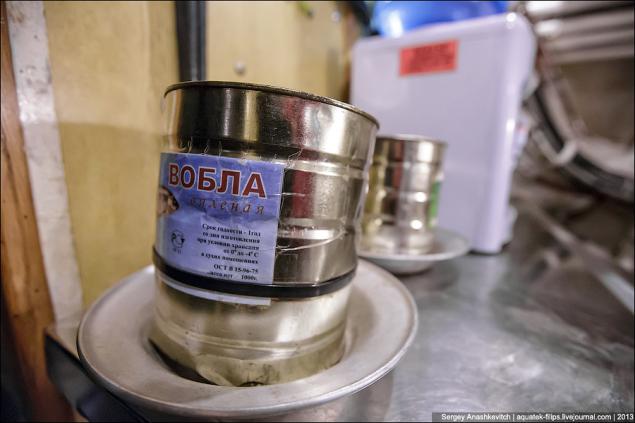
8. Latrine
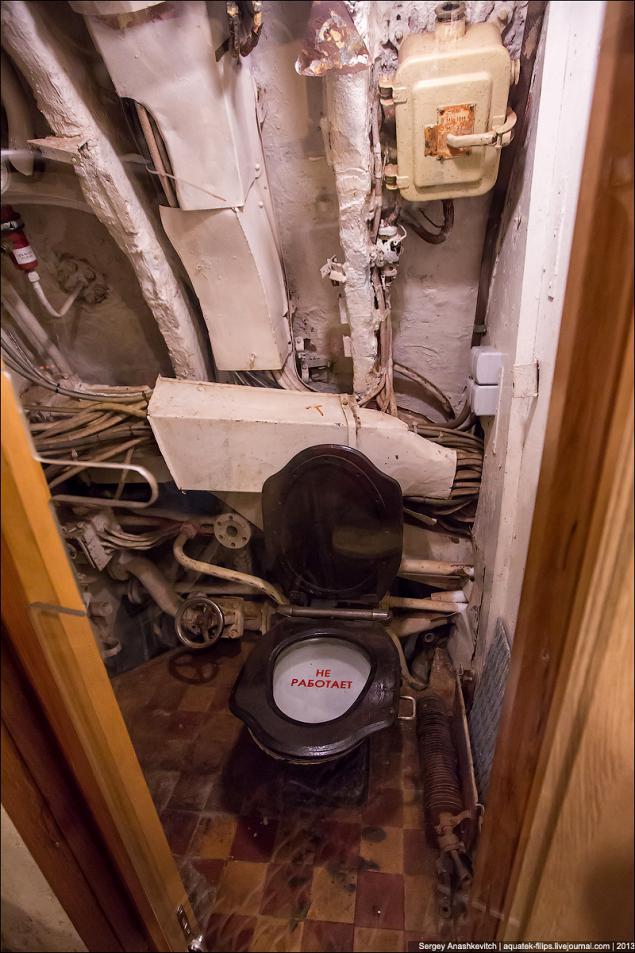
9. The interior space in a submarine is very limited, and the tall man is not enough to be comfortable. It is for this reason that the museum many pipes and communication at the level of heads are covered with colorful soft mats. And it is not in vain ... I, too, venerated
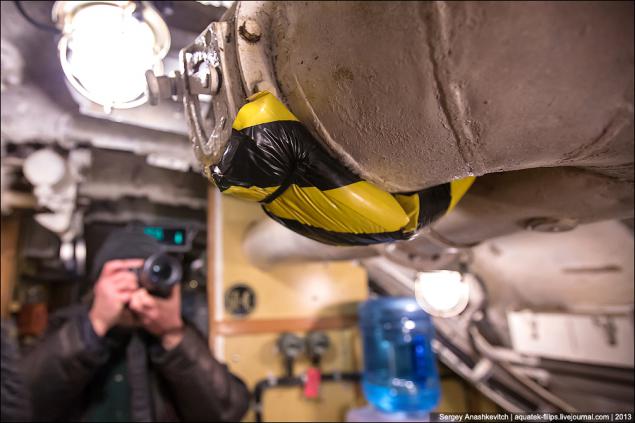
10. Go to the fifth compartment - diesel.
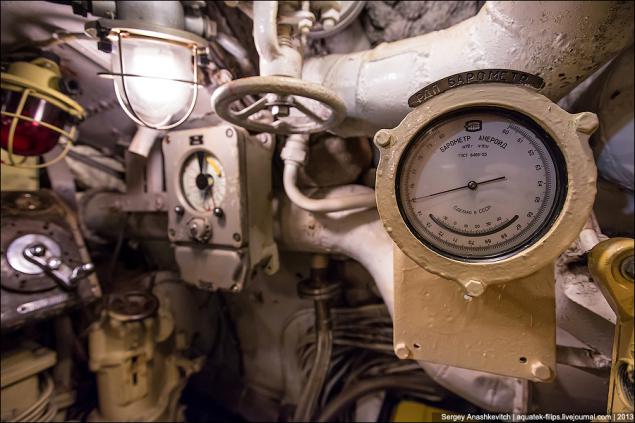
11. Controlling cameras dive

12. In the diesel compartment are 2 diesel engine control devices and systems maintenance; fuel tank, 2 diesel compressor and ship fans.

13. The basis of the power plant were the two-stroke diesel engine model 37D. In the cruise position they disperse boat top speed of 18, 25 assembly. Economic surface speed was 8-10 knots. Reserve fuel enough for 8580 miles at 10 knots or 13,000 miles at 8 knots.
In addition, the boat has two main electric motor model PG-101, had capacity 1350 liters. from. and provides high-speed full submerged speed of 13, 1 unit, which can be maintained for an hour. Two motor of economic progress model PG-103 had a capacity of 50 liters. from. and accelerates the boat under water up to a rate of 1, 97 knots. On the economic motors battery enough for 352 miles of underwater travel.

14. The narrow passages between the compartments. Each compartment is sealed and optionally can be virtually instantly isolated from the others. It worked and traveled 54 (!!!) a crew member of the boat

15. The sixth compartment - Electromotive while being residential. There are 2 main propulsion motors with main undercarriage stations, two electric motors of economic progress, the station fire extinguishing and 6 suspended beds personnel
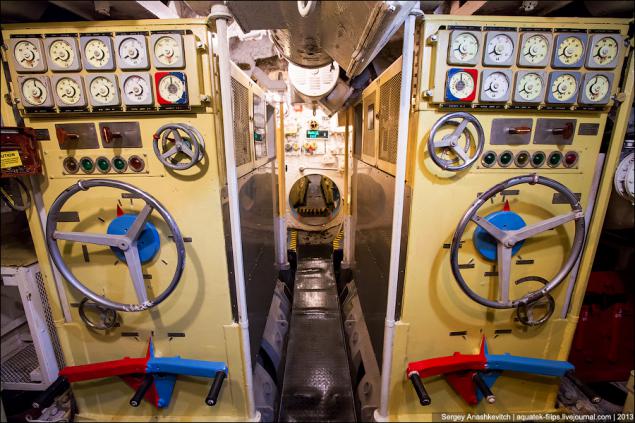
16. Why are so many on the boat - a variety of valves.

17. The seventh section - aft torpedo while living. There are 2 torpedo tubes with fire control devices, manual actuators control the vertical and horizontal stern rudders, hydraulic pump unit, bilge pump and 6 suspended beds. There is an escape hatch

18. Inside the torpedo.
Torpedoes boat was 6 torpedo tubes caliber of 533 mm 2 and 4 of the nasal feeding. For nasal devices in one compartment on racks stored 6 spare torpedoes. Instead of 10 bow torpedo boat could take 20 minutes, such as AMD-1000: two mines in each unit, and 12 minutes on the shelves. Torpedo firing was carried out from a depth of 30 meters.

19. Communication

20. A partition between the compartments

21. In the forward torpedo compartment (first) are the four torpedo tubes with fire control devices. Here the station foam extinguishing drives nasal hydroplanes, torpedopogruzochny hatch, shelving with spare torpedoes and 16 suspended beds.
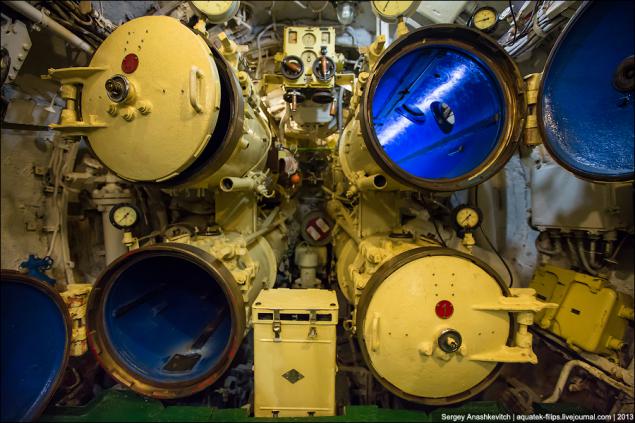
22. Berths are located directly above the torpedoes.

23. Control instruments rudders

24. The second section - the battery and at the same time living. Here are located besides another 112 batteries saloon and cabins officers, radio cutting and osnaz and high pressure air cylinders.
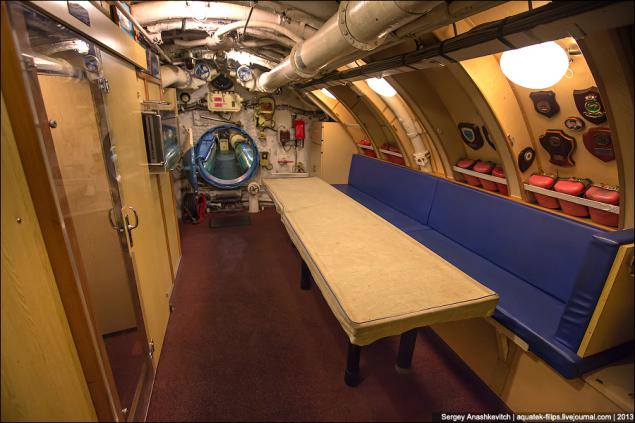
25. Radio Room. Complex electronic equipment 613 in the project during the construction and operation of repeatedly changed. Submarines received radar detection of surface targets "Flag". Sonar "Tameer-5L" and shumopelengovaniya station "Mars-24KIG" (later replaced by "Phoenix") provided the detection of targets in a submerged position.

26. The third section - the central post (or main command post). Here are arranged cutting sonar and radiometry, Mate en closure, periscope assemblies of control rate, depth, diving and surfacing, gyrocompass, torpedo tube shooting, handling mast extendable device, the main bilge pump, artpogreb, provision store, latrine and lower conning-tower hatch
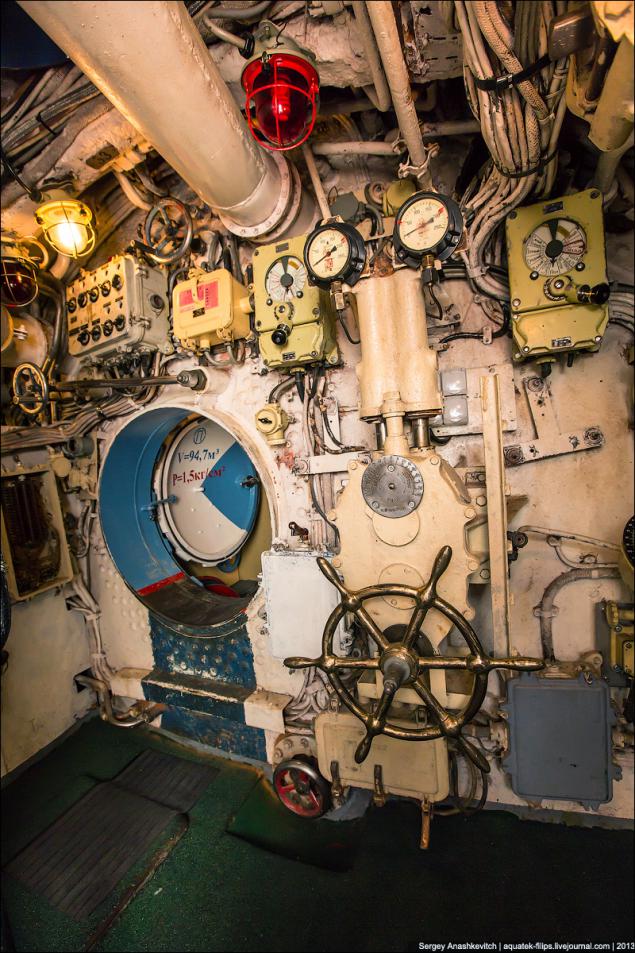
27. The ship's clock. They are a little different from our usual - here the scale consists of 24 hours instead of 12 ...

28. navigational en closure. Here there is a plotting of the submarine

29. The endless blue and red gates

30. Periscope
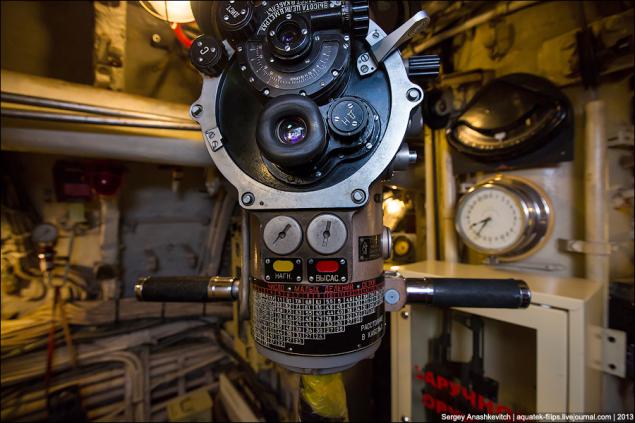
31. inclinometer. The device is very similar to the normal level of construction.

32. Further development of the project was the project 633 613 such boats were built already considerably less - only 20 ...

Source:
One of the hundreds of KB was CDB-18, where he developed an entirely new type of submarine, dubbed Project-613.
In 1950, it had been launched the first vessel of the new project, which has become the most widespread type of attack submarines in the postwar history of the USSR. Total from 1951 to 1958 was built 215 submarines of this project in the USSR, and 21 - in China.
32 Photo © Sergey Anashkevich

Marine C-189 project 613 has been laid at the Baltic plant March 31, 1954 and launched on 4 September. In addition to military campaigns, she participated in the testing of new models of weapons at the site of Lake Ladoga. Until 1988 it passed a diving school thousands of sailors, sergeants and officers. After serving almost 35 years, he was removed from the Navy in 1990 and later, in 1999, sank in the port of Kronstadt Merchant harbor, sunk at the dock on the ground because of the loss of buoyancy.
In 2005, at the expense of a businessman and a former submariner Andrew Artyushina submarine was raised and placed in the dock on Kanonersky factory where has found a second birth. After the repair and restoration of the interiors on its base was created a private museum, which opened March 18, 2010 at the Lieutenant Schmidt quay in St. Petersburg.

3. In 1942, the designers of CDB-18 began to work on the draft of a new medium submarine, designed to replace the boats of the "Pike." The project was number 608, was appointed chief engineer VN Peregoudov. In 1944, both projects were submitted to the Office of shipbuilding, but did not receive support from the non-fulfillment of the requirements for armament and range.
July 30, 1944 in the Gulf was sunk by a German submarine U-250 Type VIIC. Sunken at a depth of 27 meters in October, lifted the boat and towed to Kronstadt. The People's Commissar of the Navy NG Kuznetsov in January 1945 issued an order according to which stopped work on the project 608 and 613 began to create a project that was to be based on the structure of the German boat, but with a slight increase in tonnage from 770 to 800 tonnes . After the war, Soviet specialists familiar with the unfinished German "elektrolodkami" type XXI, who were captured in the shipyards of Danzig. In the spring of 1946 from the United Kingdom were received four unfinished boat type XXI. The result of sea trials of these ships was a complete change in the terms of reference for the project 613 in August 1946, and the type XXI was used as the basis of a new draft of the main post-war Soviet submarine. Draft project was completed in October 1947, working drawings were prepared by August 1948.
The construction of submarines of Project 613 was conducted from 1950 to 1957. Annual production reached 73 units.

4. Project 613 has a double-hulled design. All-welded robust housing with an external placement of the frames is divided by watertight bulkheads 7 compartments - 2 torpedo residential, 2 battery housing, the central post, diesel, Electromotive

5. Descent, or if I may say so, "main entrance" into a submarine

6. Right from the entrance, we find ourselves in the fourth section, which is the battery. I must say that each of the compartments of any submarine has a lot more purpose, what may appear to be based on its name.
So, in the 4th (the battery) the battery compartment located 112 46SU (below deck in the storage pit), galley, mess room and cabins warrant, electric compressors, high pressure air cylinders, etc.

7. In the galley there is even stocks dried roach ...

8. Latrine

9. The interior space in a submarine is very limited, and the tall man is not enough to be comfortable. It is for this reason that the museum many pipes and communication at the level of heads are covered with colorful soft mats. And it is not in vain ... I, too, venerated

10. Go to the fifth compartment - diesel.

11. Controlling cameras dive

12. In the diesel compartment are 2 diesel engine control devices and systems maintenance; fuel tank, 2 diesel compressor and ship fans.

13. The basis of the power plant were the two-stroke diesel engine model 37D. In the cruise position they disperse boat top speed of 18, 25 assembly. Economic surface speed was 8-10 knots. Reserve fuel enough for 8580 miles at 10 knots or 13,000 miles at 8 knots.
In addition, the boat has two main electric motor model PG-101, had capacity 1350 liters. from. and provides high-speed full submerged speed of 13, 1 unit, which can be maintained for an hour. Two motor of economic progress model PG-103 had a capacity of 50 liters. from. and accelerates the boat under water up to a rate of 1, 97 knots. On the economic motors battery enough for 352 miles of underwater travel.

14. The narrow passages between the compartments. Each compartment is sealed and optionally can be virtually instantly isolated from the others. It worked and traveled 54 (!!!) a crew member of the boat

15. The sixth compartment - Electromotive while being residential. There are 2 main propulsion motors with main undercarriage stations, two electric motors of economic progress, the station fire extinguishing and 6 suspended beds personnel

16. Why are so many on the boat - a variety of valves.

17. The seventh section - aft torpedo while living. There are 2 torpedo tubes with fire control devices, manual actuators control the vertical and horizontal stern rudders, hydraulic pump unit, bilge pump and 6 suspended beds. There is an escape hatch

18. Inside the torpedo.
Torpedoes boat was 6 torpedo tubes caliber of 533 mm 2 and 4 of the nasal feeding. For nasal devices in one compartment on racks stored 6 spare torpedoes. Instead of 10 bow torpedo boat could take 20 minutes, such as AMD-1000: two mines in each unit, and 12 minutes on the shelves. Torpedo firing was carried out from a depth of 30 meters.

19. Communication

20. A partition between the compartments

21. In the forward torpedo compartment (first) are the four torpedo tubes with fire control devices. Here the station foam extinguishing drives nasal hydroplanes, torpedopogruzochny hatch, shelving with spare torpedoes and 16 suspended beds.

22. Berths are located directly above the torpedoes.

23. Control instruments rudders

24. The second section - the battery and at the same time living. Here are located besides another 112 batteries saloon and cabins officers, radio cutting and osnaz and high pressure air cylinders.

25. Radio Room. Complex electronic equipment 613 in the project during the construction and operation of repeatedly changed. Submarines received radar detection of surface targets "Flag". Sonar "Tameer-5L" and shumopelengovaniya station "Mars-24KIG" (later replaced by "Phoenix") provided the detection of targets in a submerged position.

26. The third section - the central post (or main command post). Here are arranged cutting sonar and radiometry, Mate en closure, periscope assemblies of control rate, depth, diving and surfacing, gyrocompass, torpedo tube shooting, handling mast extendable device, the main bilge pump, artpogreb, provision store, latrine and lower conning-tower hatch

27. The ship's clock. They are a little different from our usual - here the scale consists of 24 hours instead of 12 ...

28. navigational en closure. Here there is a plotting of the submarine

29. The endless blue and red gates

30. Periscope

31. inclinometer. The device is very similar to the normal level of construction.

32. Further development of the project was the project 633 613 such boats were built already considerably less - only 20 ...

Source:













